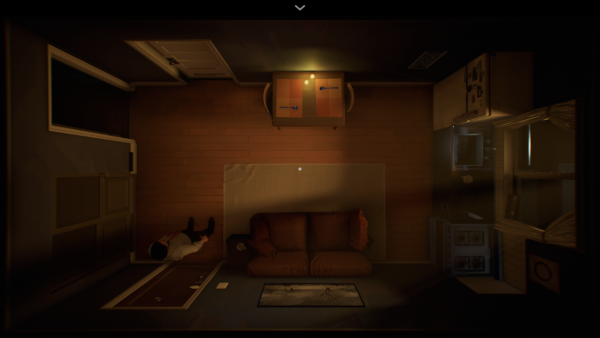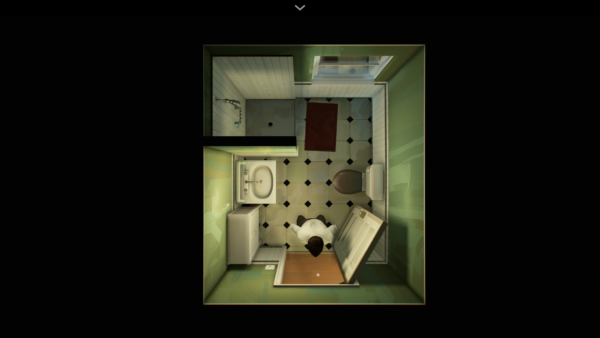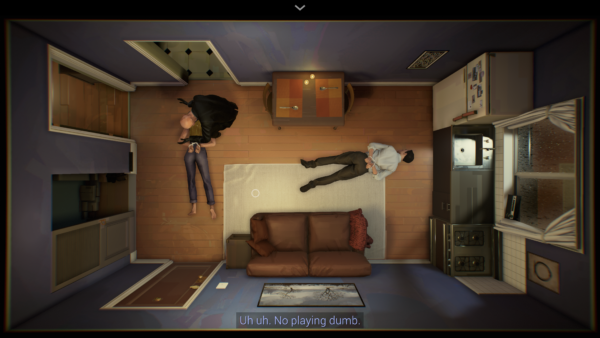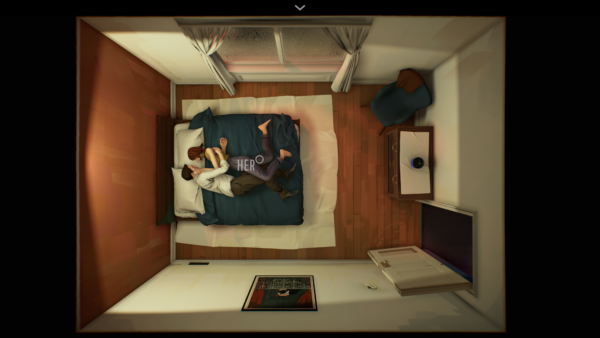It is a dark and stormy night, and you are stuck in a small apartment playing events in a time loop over and over again that span 10 minutes.
The game is Twelve Minutes, a point-and-click murder mystery that features a time-looping mechanism in which you need to solve the mystery over tine minute time-loops.
Featuring a Hollywood A-list star-studded cast of James McAvoy (young Professor X in X-Men: First Class), Daisy Ridley (Rey Skywalker from A Force Awakens) and Willem Dafoe (Green Goblin in Spider-Man films), Twelve Minutes scores high on star power and voice acting.
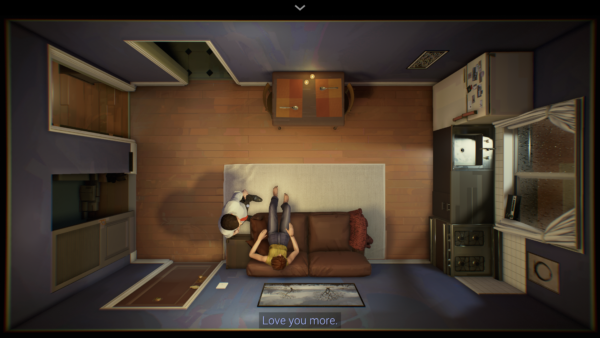
Despite the small setting of the game, there are many graphical details to appreciate, like the raindrops on the windows and moving lights from the traffic. SCREENSHOT: Yap Hui Bin
Showtime, storytime
You play the male protagonist who comes home from work to a small apartment that he shares with his wife and is looking forward to a romantic evening together.
Suddenly, a police detective knocks on the door, arrests your wife and beats you to death. All these events occur in less than 10 minutes, and you need to figure out what actions and experiment with different sequences of actions and dialogue options to solve the mystery and break the time loop.
With many plot twists in the game, and this being a spoiler-free review, all I can say is that there is plenty of trial and error in the game, but with each slight variation in events, you can gain some revelations, reveal the twists to the plot and piece together the clues to solve the mystery.
Rewind, repeat
Wait a minute, aren’t there similar games that use this time-loop mechanism quite recently? It does seem so, with recent releases like The Forgotten City, Returnal and Deathloop featuring some form of time looping and manipulation.

Ten minutes is all you have to discover a new clue that can help you change a certain sequence of events and glean more insights. SCREENSHOT: Yap Hui Bin
What sets Twelve Minutes apart is its unique setting in a very contained space where everything you need to solve the mystery within the tiny apartment. The game also shows how much can be done within ten minutes to alter one’s fate.
Only by trial and error to create certain situations will you get information from the characters pertaining to the mystery you are trying to solve and to break out from the time loop.
There are moments of tension especially when you know you have to get a sequence of actions timed just right, as scripted events start within a minute or so. If you missed it, then you need to try that sequence of events again in the next time loop.
At critical junctures, I find myself having to pause at the start of certain loops to mentally rehearse the sequence of actions I need to take in order to yield a certain breakthrough, or trigger a new dialogue option.

A point-and-click murder mystery game, Twelve Minutes offers some unique perspectives. SCREENSHOT: Yap Hui Bin
Sometimes even a small, unintentional slip can upset the sequence that you have planned out. For instance, I accidentally performed an action within sight of another character, and that character intervened and disrupted what I planned to do, which meant I needed to orchestrate the entire sequence of events again and be careful not to mess it up.
As with other time looping games, the other characters will not remember the conversations you had previously, so expect to hear the same lines many times. Thankfully, you can always skip the dialogue to get to the point where you need to take a different action or pick a different dialogue option.
So, why is the title of the game Twelve Minutes when each loop is 10 minutes long? For that, you will have to play the game to find out!
Time after time
Twelve Minutes has several endings, with one “ideal” ending which ends the game properly, as well as some that can be considered endings but with a way to try again. At one point I thought I had unlocked the perfect ending, but the looping still happened, so that forced me to play through again, looking for more clues to tie up all the loose ends.
I finally managed to break the loop and got to one of the conclusive endings with end credits in about five hours of gameplay. It took me a few more to unlock the other endings and complete the achievements, so there is definitely a lot more gameplay if you like to satisfy your curiosity by leaving no stone unturned and no achievement uncompleted.

Leave no stone unturned in finding clues to break the time loop. SCREENSHOT: Yap Hui Bin
Unfortunately, the game seems to be built around delivering shock value and the story isn’t very coherent. The ending of the story seems rather illogical, although it does have sufficient twists and shocking revelations to keep the gamer engaged.
Still, it left me rather puzzled and confused how certain major events can be so casually overlooked. Even when using convenient plot devices, which the so-called “ideal” ending used to try to explain how certain events happened, I feel it is still quite a stretch.
Déjà view
Twelve Minutes feels almost like a stage play with only a small set and cast and the plot strongly driven by the narrative. As such, the graphics are not the main highlight, although the attention to detail is pretty impressive, such as raindrops falling on window panes, moving lights from traffic, as well as the eerie lightning flashing outside the window

With a top-down perspective, strong acting through voice and body language is critical for Twelve Minutes. SCREENSHOT: Yap Hui Bin
What’s unique about Twelve Minutes is that you never get to see the actors’ faces too clearly. All of the acting is portrayed in the form of body language and voice, hence the need for a strong cast to pull this off.
In this respect, I thought Willem Dafoe playing as the detective did an astounding job with his gravelly voice. It is soft and gentle at times, and yet brutal and terrifying when needs be.
Being in an enclosed space, the audio effects of Twelve Minutes also play a huge role in the game. The ambient sounds accurately reflect the atmosphere of the tiny apartment well.
You can hear the muffled crying of the baby next door, the sound of footsteps and thunder outside the apartment and the difference in sound texture when heard through an open or closed door.
Audio cues like the music becoming more tense as the next minute approaches adds to the suspense in the game, especially when you realise you are running out of time or are powerless to stop the inevitable.
In Twelve Minutes, it pays to pay attention to details, as many of the achievements are based on conscientious effort and observation. I also like that even the reflections off the face of a watch can hint at changes in the scenarios in repeated playthroughs, which rewards the observant gamer.
With adult themes of murder and violence, as well as frequent swearing by all characters, Twelve Minutes is best played when Junior isn’t in the room.

Twelve Minutes rewards the detail-oriented gamer with lots of hidden secrets to be found. SCREENSHOT: Yap Hui Bin
TL;DR
Twelve Minutes plays longer than 12 minutes, although it can be completed relatively quickly in around five hours – more, if you want to unlock all the endings and achievements.
With a small, star-studded cast of A-list Hollywood actors, as well as plot twists that score high on shock value, Twelve Minutes engages the player until the mind-boggling and head-scratching end.
Twelve Minutes is available on Steam for S$24 and on the Xbox Store at S$36. It is free to play on Xbox Game Pass at the moment, so give it a go you if you like murder mysteries that test your power of deduction and observation.
